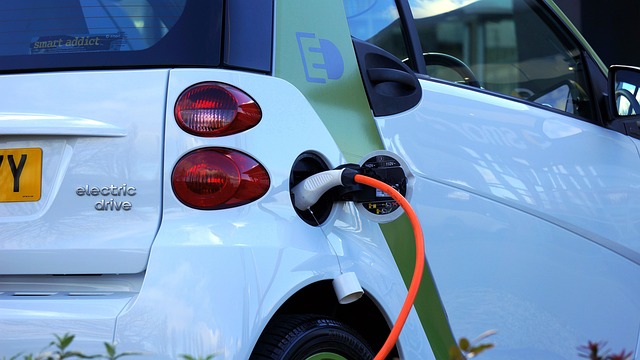Commuting's environmental and economic impact highlights the need for green initiatives. Choosing sustainable vehicles like electric cars reduces emissions, saves costs, and promotes healthier environments. Smart cities integrate e-mobility, offering incentives for eco-friendly travel choices. Biodegradable motor oils further minimize environmental impact. The shift to electric vehicles, with growing charging infrastructure, drives innovation. Active transportation encourages cycling and walking. Community engagement and policy interventions promote sustainable fleet choices, reducing carbon footprints through infrastructure development. Select Sustainable Vehicles are key to a greener future.
Green commuting initiatives are transforming the way we travel, offering significant benefits for both individuals and the environment. This article explores various aspects of sustainable transportation, from understanding the impact of eco-friendly commute choices to popular options like electric vehicles and active transport. We delve into incentives driving adoption, charging infrastructure challenges, and community engagement strategies. By examining these key areas, we highlight how individuals can select sustainable vehicles for a greener future.
- Understanding Green Commuting: Benefits and Impact
- Popular Sustainable Transport Options for Daily Use
- Incentives and Policies Promoting Eco-Friendly Travel
- Electric Vehicles: Charging Infrastructure and Adoption
- Active Transportation: Cycling and Walking Initiatives
- Community Engagement in Reducing Carbon Footprint Through Commute Choices
Understanding Green Commuting: Benefits and Impact

Commuting is a significant aspect of daily life, and adopting green commuting initiatives offers numerous environmental and economic benefits. By selecting sustainable vehicles, such as electric cars or hybrids, individuals contribute to reducing greenhouse gas emissions and air pollution. This shift towards eco-friendly transportation options not only diminishes our carbon footprint but also fosters a healthier living environment for all.
Moreover, embracing green commuting practices can lead to substantial long-term savings. Consider the advantages of biodegradable car parts for responsible consumers; these innovations ensure that vehicles become more environmentally friendly at every stage of their lifecycle. Additionally, eco-friendly auto maintenance practices can help extend vehicle lifespans while minimizing waste, further promoting sustainability. In terms of smart cities, e-mobility solutions are revolutionizing urban transportation, making it more efficient and environmentally conscious.
Popular Sustainable Transport Options for Daily Use

In today’s world, green commuting initiatives are gaining traction as folks become more aware of their environmental impact. Among the popular sustainable transport options for daily use, electric cars for eco-conscious commuters stand out for their zero-emission capabilities and energy efficiency. These vehicles not only reduce carbon footprints but also contribute to cleaner air in urban areas. Additionally, carbon offsetting for vehicles plays a crucial role in balancing out the remaining emissions that cannot be eliminated through direct means.
Beyond personal vehicles, sustainable transportation planning for urban development is transforming cities into greener spaces. This involves promoting public transit, cycling networks, and pedestrian-friendly infrastructure. Even the simplest changes, like encouraging carpooling or implementing zero-waste car washes for eco-friendly cleaning, can collectively make a significant difference in reducing environmental impact. Furthermore, using biodegradable car waxes and polishes ensures that even personal vehicle care aligns with sustainable practices, completing the holistic approach to green commuting.
Incentives and Policies Promoting Eco-Friendly Travel

Many cities and countries are encouraging green commuting initiatives through various incentives and policies that promote eco-friendly travel. One key strategy is to select sustainable vehicles for public transport, such as electric cars or solar-powered charging buses. These alternatives significantly reduce carbon emissions compared to traditional fuel-guzzling options. Governments often offer tax breaks, subsidies, and other financial benefits to both individuals and businesses that adopt these eco-friendly modes of transportation.
Additionally, policies like carpool lanes, congestion pricing, and preferential parking for low-emission vehicles further incentivize commuters to choose more sustainable travel methods. The use of biodegradable motor oils also plays a crucial role in minimizing the environmental impact of everyday driving, contributing to a cleaner and greener future for all.
Electric Vehicles: Charging Infrastructure and Adoption

The rise of electric vehicles (EVs) is a cornerstone of many green commuting initiatives, offering a sustainable alternative to traditional gasoline-powered cars. As more people consider select sustainable vehicles for their daily journeys, the expansion of charging infrastructure becomes essential. Governments and private entities are investing in this network of charging stations to support EV adoption and alleviate range anxiety among consumers. Efficient and accessible charging options are crucial for encouraging wider use of electric cars, helping to reduce carbon emissions from transportation.
The growing popularity of EVs also presents opportunities for innovation. For instance, solar-powered vehicles could further minimize the environmental impact of car ownership, while zero-waste car washes promote eco-friendly cleaning practices. Additionally, green car incentives and rebates provided by various jurisdictions and manufacturers make purchasing an EV more affordable, accelerating a shift towards cleaner commuting options. These advancements collectively contribute to a future where electric airport shuttles and other forms of electric public transport could become the norm, significantly reducing pollution and promoting a greener lifestyle.
Active Transportation: Cycling and Walking Initiatives

Active Transportation encourages commuters to embrace cycling and walking as viable and sustainable modes of travel within urban areas. This eco-friendly approach not only reduces traffic congestion but also significantly lowers carbon emissions, contributing to cleaner air and a healthier environment. Governments and local authorities are increasingly promoting these initiatives by developing dedicated bike lanes, pedestrian-friendly infrastructure, and smart city technologies that provide real-time data on route planning and traffic conditions.
Select Sustainable Vehicles play a crucial role in enhancing green commuting efforts. Bicycles, for instance, offer an efficient, cost-effective, and low-impact alternative to motor vehicles, while encouraging active lifestyles. Moreover, with the advent of electric bikes (e-bikes) and innovative designs like sustainable shipping containers transformed into mobile cargo bikes, commuting becomes more accessible and appealing. Even for longer distances, walking remains a powerful tool in reducing personal carbon footprints, and many cities are revitalizing their walkability through smart urban planning and the integration of green spaces.
Community Engagement in Reducing Carbon Footprint Through Commute Choices

Community engagement plays a pivotal role in reducing carbon footprints through commute choices. By actively involving residents, businesses, and local authorities, green commuting initiatives can gain traction and foster a collective sense of responsibility for environmental sustainability. Educational campaigns that highlight the benefits of selecting sustainable vehicles, such as electric cars or hybrid models, can empower individuals to make informed decisions. These efforts are further amplified by policy interventions that incentivize eco-conscious fleet vehicle choices, thereby encouraging a transition towards cleaner transportation options.
In addition to promoting individual actions, community engagement should also focus on infrastructure development. Implementing energy-efficient lighting for garages and integrating e-mobility solutions within smart cities can significantly reduce emissions from commuting activities. Furthermore, leveraging recycled materials for automotive interiors not only diminishes environmental impact but also promotes a circular economy, where resources are reused and repurposed, contributing to a more sustainable future for all.
Green commuting initiatives play a pivotal role in mitigating environmental impact and fostering sustainable communities. By understanding the benefits, exploring diverse transport options, and adopting supportive policies, individuals can contribute to reducing their carbon footprint. Encouraging the use of electric vehicles, active transportation, and community engagement ensures a more eco-friendly future where sustainable commute choices become the norm. Selecting sustainable vehicles and promoting green travel practices are key steps towards a greener world.



